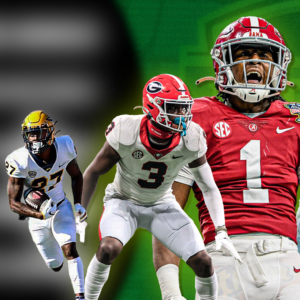Cooper DeJean is the definition of an athlete. Attending high school in Iowa, he started at quarterback and defensive back. He had multiple seasons where he passed for over 3,400 yards while also rushing for over 1,200 yards. A multisport athlete, lettering in baseball, basketball and track, he was the 2A state champion in the 100-meter dash and long jump as a senior. We’ll see many instances where his multisport background translates to the football field.
At the University of Iowa, DeJean was a unanimous consensus first team All-American at cornerback as a true Junior. He was also first team All-Big Ten as a return specialist as well. He has won several Iowa special teams awards over the years, as well as Iowa’s Hustle Award during his sophomore season. He declared for the NFL after his junior season.
DeJean played all over the defense for Iowa, with time as an outside corner, slot corner and strong safety. Due to his athletic profile and skill set, he is a player that can be a versatile weapon for many NFL teams. It will be interesting to see if the team that selects him will prefer to keep him at outside corner or move him around the defense.
Athletic Ability
The Iowa Hawkeyes website lists DeJean at 6’1” and 207 lbs. He is a well-built, muscled up player for a typical corner. He has solid long speed and explosiveness.
Some people will qualify DeJean’s speed as elite by mentioning that he is a state champion in the 100-meter dash and leave it at that. What they will leave out is that he ran an 11.16. For comparison, he would’ve finished last in the 2023 Florida 4A state championship meet by over two-tenths of a second.
While DeJean has likely added speed since high school, there are times on film where faster receivers are able to get a step on him.
To go along with his size, he has good strength to battle against bigger wideouts and tight ends. This shows up at the line of scrimmage, holding ground at the top of routes, or when taking on blockers of all builds.
While he has good strength and solid long speed, his rocked-up frame comes with some hip tightness. This does hinder him when needing to flip his hips to run with a receiver or when needing to change directions at the break point. As a result, his change of direction and agility are only slightly above average at best.
Strengths
Ball Skills
As mentioned before, DeJean is a multisport athlete. You can really see that baseball background show up when he’s tracking and playing the ball in the air. You see that play out on an interception against Rutgers where he made a Willie Mays style catch that he returned for a touchdown.
When breaking on the ball, DeJean takes aggressive angles to try to undercut routes. When he does get his hands on the ball, he is a threat to take it to the house. He has returned three interceptions for touchdowns in his career (although it should be noted that two of those touchdowns were due to very late balls). In addition to that, he is a very skilled punt returner and has broken several long plays in his two seasons as a returner.
Strength against Bigger Body Types
DeJean’s size really comes into play when battling against bigger body types, whether they are receivers or tight ends. This is where his versatility becomes clear. At the line of scrimmage, when he’s able to get a two-hand jam or get physical with a receiver, he’s often able to end the route.
At the top of routes, when physical receivers try to push off to create separation, he’s able to hold his ground and get back into position to make plays on the ball. He won’t get bullied by bigger receivers and his size and play strength will allow him to match up against receiving tight ends at the next level.
Recognition of QB Drop and Route Combinations
As a zone defender, Cooper DeJean excels at reading the drop and body language of the QB to be able to break on passes or run deep with receivers. He also does a great job of recognizing route combinations and adjusting his drop to put himself in better position to attack the football.
Look back at that Willie Mays interception from earlier. DeJean did a great job of falling off the drag route and then finding the crossing route coming back across the field. Also notice that he only glanced at the crossing route before reading the QB and letting his eyes take him to the ball.
Run Support, Tackling & Block Destruction
DeJean is a plus defender when it comes to the less glamorous side of playing cornerback. He’s physical when attacking blocks on the perimeter and he’s strong enough to mix it up with offensive linemen when they get up to the second level.
He has experience playing in the box as well, further enhancing his value to a defense. While he’s not a player that should be put in position to take on offensive linemen often, he has the vision and feel to find and penetrate open windows, and the willingness to take on bigger backs.
In space, DeJean is a good tackler, closing space quickly before coming to balance and wrapping up. He’s also aware to leverage the sideline for help when the opportunity presents itself. While his change of direction skills will lead to him missing some tackles against the most elusive playmakers in space, it’s not a huge concern for him. Over the past two seasons, DeJean has the second most tackles of all corners in the Power Five Conferences and is 18th in missed tackle percentage in that time.
DeJean’s best strength is his versatility to play inside, outside or in the box. He is good against the run and his ball skills and ability after the catch makes him a dangerous weapon. Being able to move around the field for a defense is something creative coordinators will cherish.
Weaknesses
Hip Tightness, COD & Agility
DeJean has better long speed than change of direction quickness, mainly due to less-than-ideal hip mobility. His tight hips prevents him from being able to turn and run with receivers in a smooth motion or to redirect and break downhill in a timely fashion.
Due to his hip tightness, he has to flip his hips a little earlier in the route than others. When his hips are flipped to run vertically, he has trouble planting, turning and exploding back downhill as quickly as many other corners in this class. You will often see him take two to three hitches when he needs to plant and break back on curls or comebacks. This is an unfortunate combination for him; he often plays out of a side shuffle so that he’s not late turning to run with wideouts, but his hitch at the top of routes makes it difficult for him to get back in position to play the ball.
DeJean will struggle in the pros against receivers that are able to get in and out of their breaks quickly.
Over the past two seasons, of the top 200 corners in terms of coverage targets in the Power Five, DeJean ranked 143rd in forced incompletion rate when targeted. His change of direction skills are a big reason why. He’s often just a step late contesting passes.
Press Technique
His hip tightness really shows up in press. His technique in press is not great to begin with, but a lot of it likely stems from him having to use a two-step motion to be able to open his hips to run vertically. When you watch DeJean in press, he consistently opens the gate and allows receivers to run straight down the field without having to alter their release much.
This often forces DeJean into chase mode to get in phase instead of being able to squeeze wideouts to the sideline from the get go. This lets receivers have too much space to work towards the sideline to drift underneath deep passes and makes it incredibly difficult for DeJean to get in a position to look and lean to find the ball. He ends up having to face guard receivers and he has trouble locating the ball down the sideline. Against fast and skilled wideouts, he will get stacked. Against slower wideouts, he is able to get back in phase.
DeJean is best playing the ball when he doesn’t have to turn and run. When he’s able to keep receivers in front of him and his eyes on the QB, he does a good job exploding downhill and playing physical through the catch point.
Fit
As an outside corner, Dejean’s best fit is in a zone heavy coverage scheme where he can key the QB and read routes from an off alignment. Lack of fluidity and COD skills will make it difficult for him to thrive in a man heavy scheme, especially against shifty WRs. While he has solid long speed, fast WRs will challenge him vertically.
His versatility is his most redeeming quality. His experience playing outside, in the slot and in the box and his size and willingness to engage in contact allows him to be moved all over. Although I think Cooper DeJean can play outside corner in the NFL in certain schemes, I think his most likely path to becoming a high-level impact player is at safety or in a role where he can be moved throughout the defense, similar to how Kyle Hamilton is used for the Ravens.
To be clear, I’m not saying he will be Kyle Hamilton, but DeJean is a chess piece that can be utilized in different spots, from safety, to outside corner against bigger wideouts, or inside as a big nickel on run downs or in blitz situations. If you are looking for a pure cover corner, there are better options in this draft. If you’re looking for an all-around playmaker at defensive back, then there is not many better players in this draft.




